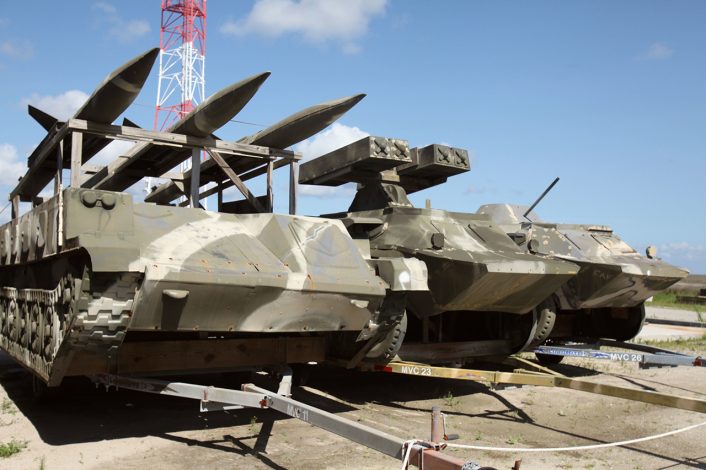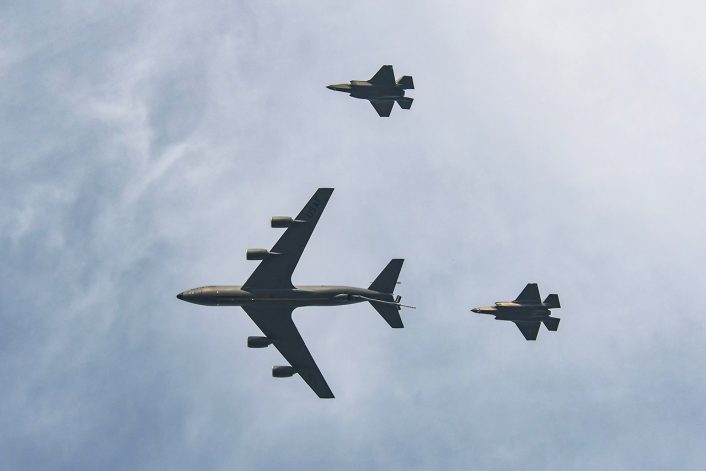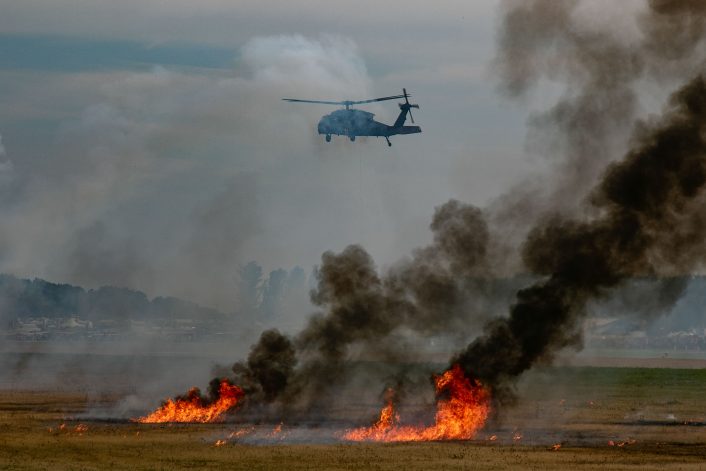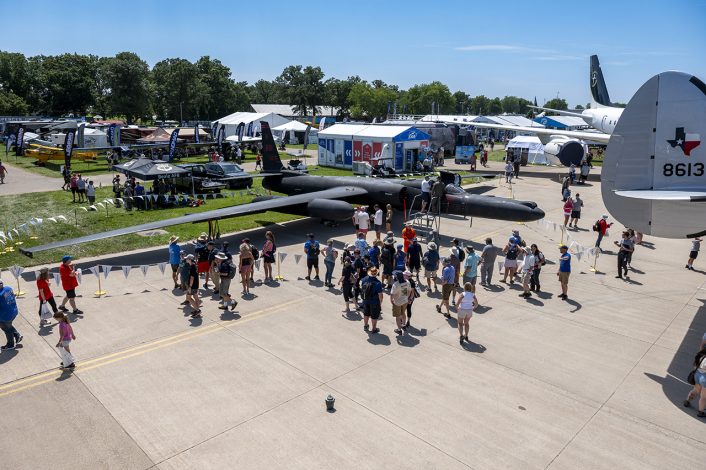Part of the U.S. Military contingent at this year’s EAA AirVenture event, the local Wisconsin Air National Guard showed off a range of its equipment, including a full scale surrogate target replica of a Chinese HQ-16 surface to air missile system.
The latest to be revealed in a series of surrogate target vehicles utilised by the U.S military to simulate Chinese equipment, the HQ-16 surrogate target appears to replicate the multi-function radar vehicle that forms part of an HQ-16 battery. The ‘radar’ can be seen deployed upwards from the rear of the vehicle.
Surrogate targets are used to provide military crews, particularly those operating aircraft, a full scale visual representation of what they could expect to see in a combat situation to aid their recognition and identification skills. In many cases the targets are designed to also replicate the real equipment’s radar signature as much as possible, and can also be adapted to mimic their expected infrared signatures.
By pairing surrogate targets together, visually accurate clusters or bases of hostile forces can be replicated quickly within training areas. Importantly, by constructing the replicas to be easily transportable the targets can also be repositioned rapidly and allow ranges to be dynamic, just like a real battlespace, presenting new challenges to personnel for each sortie.
Other than missile launchers and radar systems, types of equipment frequently replicated using surrogate targets include aircraft, tanks, and artillery guns and launchers.
A segment from the video that shows a ROKAF F-35A dropping an inert GBU-12, which scores a direct hit on a moving target (a surrogate ballistic missile TEL) at the Pilsung Firing Range. https://t.co/dVJrlB4NJf pic.twitter.com/t7brYSh2TL
— Guy Plopsky (@GuyPlopsky) April 19, 2024
The practice of using full scale replicas in this fashion is fairly common and features extensively both within the U.S. military and overseas. In June we reported on elaborate mockups of Russian equipment positioned within a large Italian training range.

Surrogate targets can range from these high fidelity replicas all the way down to crude inflatable, wood, or sheet metal constructions, sometimes with identifiable details marked on the sides with paint. Both types can provide training value depending on the exact case of their use. Simpler and less expensive replicas can be employed for live fire exercises which would destroy comparatively expensive high fidelity replicas.
This HQ-16 mock up is exceptionally detailed even when compared to some of the highest fidelity replications and would certainly look close to the real thing when viewed from a long range through electro-optical sights.

In some cases, the U.S. and a number of other nations have been able to procure genuine articles of opposing force equipment for use on training ranges. These are often, of course, the most valuable of all targeting aids. Notably, the U.S. has even been seen operating Russian or Soviet-built radar systems near their training facilities to provide an effective 1:1 simulation, and also ensure radar cross-section reduction measures are effective against frontline platforms.
One well known area where this practice is apparent is around the outskirts of Area 51, or Groom Lake. Research website Dreamland Resort has cataloged various sites in the area where non-American equipment from various eras is visibly deployed alongside support buildings and provision for communications and electrical power. Unlike surrogate targets as shown off at Oshkosh, these sites are not as easily transportable or configurable by regular personnel, instead likely requiring very particular knowledge and experience to operate correctly and safely. New types of radar systems around the Nevada Test and Training Range (NTTR) have been noted being added on a regular basis.
To the south, at Nellis Air Force Base, the U.S. Air Force operates a facility it affectionately refers to as the ‘petting zoo’. Housing an impressive collection of foreign military equipment acquired through various means over the years, the facility is used to intimately familiarize U.S. military personnel with opposing equipment and technologies. It is maintained by the 547th Intelligence Squadron, who are responsible for producing the U.S. Air Force’s threat reference guide.

Historically, the primary focus of this kind of equipment acquisition has been on Russian and Soviet designs, but in recent years China’s rapid technological progress and divestiture away from relying on Russian-derived equipment means that China is now in the front of threat analysts’ minds. That being said, the war in Ukraine has allowed the U.S. and its Allies extraordinary opportunities to analyse modern Russian equipment, even of types not available for export, which has been captured by Ukrainian forces.
HQ-16 Surface to Air Missile
The HQ-16 is a vertically-launched, medium range surface to air missile in service with both Chinese and Pakistani forces. Considered to be derived from the Russian ‘Buk’ SAM system, the missile was first deployed in vertical launch cells on People’s Liberation Army Navy surface vessels.
Land based HQ-16s began to appear in 2011, with initial variants offering a range of around 40 kilometres. Upgrades increased this to around 75 kilometres. It is one of the more numerous land based SAMs in service with the People’s Liberation Army.
Wreckage of an HQ-16 SAM in Pakistan, likely expended during the drone attack on Lahore Cantt on 8th May in which an HQ-9 Air-defence system Mobile command post was liquidated. pic.twitter.com/p1M06us97N
— Choice of Inevitability (@Mark99xm) May 20, 2025
During the May 2025 clash between India and Pakistan, HQ-16 (designated LY-80) systems were deployed by Pakistan to counter Indian aircraft, but little is known about their effectiveness.
Also at Oshkosh
Organised by the Experimental Aircraft Association in Oshkosh, Wisconsin, the annual AirVenture event is considered to be the world’s largest airshow. This year, the show clocked up 704,000 attendees, breaking its own record. Over 10,000 aircraft arrived at airfields in the area, averaging 108 take-offs and landings per hour.
Chairman and CEO of EAA Jack Pelton said “We found ourselves revising our initial attendance estimate upward once all the final weekend’s numbers were in, including from a tremendous day on Saturday, July 26. This year’s success is a credit to our 6,000 volunteers, our staff members, and our partners as they continue to raise the bar on what’s possible as we bring the aviation world to Oshkosh.”

Alongside an array of civilian aircraft displays, crowds were treated to an air to air refueling demonstration featuring a KC-135 with F-35 Lightning IIs in the midst of a Wisconsin Air National Guard exhibition of artillery, infantry, and helicopter combat.

Beale Air Force Base sent one of their U-2 Dragon Lady aircraft to the show, which was a highlight for many during its days on static display as well as its charismatic arrival and departure, much like at the recent Royal International Air Tattoo in the UK.

EAA AirVenture at Oshkosh returns in 2026 between July 20 and July 26.









